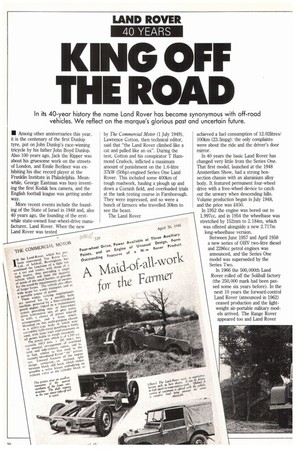LAND ROVER 40 YEARS
Page 52

Page 53

If you've noticed an error in this article please click here to report it so we can fix it.
KING OFF THE ROAD
In its 40-year history the name Land Rover has become synonymous with off-road vehicles. We reflect on the marque's glorious past and uncertain future.
• Among other anniversaries this year, it is the centenary of the first Dunlop tyre, put on John Dunlop's race-winning tricycle by his father John Boyd Dunlop. Also 100 years ago, Jack the Ripper was about his gruesome work on the streets of London, and Emile Berliner was exhibiting his disc record player at the Franklin Institute in Philadelphia. Meanwhile, George Eastman was busy inventing the first Kodak box camera, and the English football league was getting under way.
More recent events include the founding of the State of Israel in 1948 and, also 40 years ago, the founding of the erstwhile state-owned four-wheel-drive manufacturer, Land Rover. When the new Land Rover was tested
by The Commercial Motor (1 July 1949), Lawrence Cotton, then technical editor, said that "the Land Rover climbed like a cat and pulled like an ox". During the test, Cotton and his conspirator T Hammond Cradock, inflicted a maximum amount of punishment on the 1.6-litre 37kW (50hp)-engined Series One Land Rover. This included some 400km of tough roadwork, hauling a plough up and down a Cornish field, and overloaded trials at the tank testing course in Farnborough. They were impressed, and so were a bunch of farmers who travelled 30km to see the beast.
The Land Rover achieved a fuel consumption of 12.021itres/ 100km (23.5mpg): the only complaints were about the ride and the driver's door mirror.
In 40 years the basic Land Rover has changed very little from the Series One. That first model, launched at the 1948 Amsterdam Show, had a strong boxsection chassis with an aluminium alloy body. It featured permanent four-wheel drive with a free-wheel device to catch out the unwary when descending hills. Volume production began in July 1948, and the price was £450.
In 1952 the engine was bored out to 1,997cc, and in 1954 the wheelbase was stretched by 152nmi to 2.184m, which was offered alongside a new 2.717m long-wheelbase version.
Between June 1957 and April 1958 a new series of OHV two-litre diesel and 2286cc petrol engines was announced, and the Series One model was superseded by the Series Two.
In 1966 the 500,000th Land Rover rolled off the Solihull factory (the 250,000 mark had been passed some six years before). In the next 10 years the forward-control Land Rover (announced in 1962) ceased production and the light weight air-portable military mod els arrived. The Range Rover appeared too and Land Rover headlamps were moved to the wings.
By 1976 the millionth Land Rover had been built, as part of the Series Three range. The One-Ten Series debuted in 1983, and in 1984 the faithful 2,250cc diesel was replaced by the 2.5-litre unit.
Since then we have seen the vee-eight power unit grow from strength to strength, the turbocharged diesel model introduced, and the Range Rover takes the marque into the luxury passenger car sector. On the sales side, however, the story has not been as progressive.
ALL PARTS OF THE WORLD
Within months of the launch of the Land Rover, Completely Knocked Down (CKD) vehicles were en-route to all parts of the globe. Africa proved to be an enduring market for nearly 30 years, and there are Land Rovers at work in nearly every country in the world.
Unfortunately, the oil price crisis of 1974 hit the Third World hard, and Land Rover exports to those areas have been on a slippery slope ever since.
On the home market the slow development of the Land Rover has meant that Japanese firms have been able to successfully offer cheaper, if less competent, machines to buyers. Land Rover's market share has suffered as a result. In the 1970s the company was producing around 60,000 vehicles a year: by 1987 production was down to only 19,000.
Since 1983 Land Rover has sold fewer commercial vehicles every year, in a expanding market. The company's response has been characterised by slow product development and a lack of investment. The lack of funds has prevented the company from exploiting the growing demand for leisure four-wheel-drive vehicles.
It is ironic that the possible buyout of the company by General Motors in 1986 could have offered the company the development capital it desperately needs. The proposal was bitterly fought by a "Keep Land Rover British" campaign, with little apparent thought for the company's long term prospects.
In its 40th year Land Rover has launched a luxury version of the Range Rover, changed the colour of the company logo, and toasted the prospect of another 40 years of off-road manufacturing.
It is to be hoped that Land Rover's potential new owners (British Aerospace) have a weather eye for the future of the company. With the right backers and sufficient funds the unrivalled 4x4 workhorse will be with us into the third millennium. Otherwise, Land Rover could all too easily join Guy, AEC, Albion and Thorneycroft as great names of the past.
















































































































































